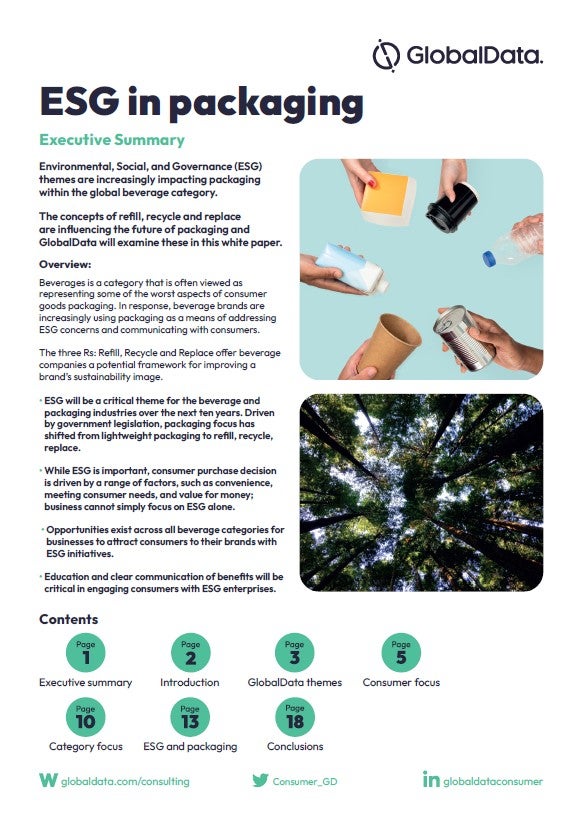
Last week (14 February) Packaging Gateway’s parent company, GlobalData, hosted a webinar for industry professionals titled ‘The top trends in food 2023 ’that brought up a number of key trends set to impact the future of the food industry.
Global content director at GlobalData, Katie Page, hosted the webinar and gave a detailed presentation on the trends currently shaping consumer purchasing behaviour as they navigate economic instabilities and financial insecurities.
How well do you really know your competitors?
Access the most comprehensive Company Profiles on the market, powered by GlobalData. Save hours of research. Gain competitive edge.

Thank you!
Your download email will arrive shortly
Not ready to buy yet? Download a free sample
We are confident about the unique quality of our Company Profiles. However, we want you to make the most beneficial decision for your business, so we offer a free sample that you can download by submitting the below form
By GlobalDataPage named five key trends that would help businesses to stay relevant during the cost-of-living crisis:
- Pack size matters
- Sustainably savvy shoppers
- New normal shopping
- Ingredient priorities
- Proactive health.
Top trends in food
Page told attendees that what happened during the recession in 2008 won’t provide a like-for-like blueprint for 2023 as the landscape is different due to the rise in online shopping and the change in lifestyle patterns.
She did point out that businesses prepared to think creatively about how to help consumers who are having to adjust their purchasing behaviour will prove to be the most resilient.
Data compiled by GlobalData showed that ‘easy and affordable’ experienced a gradual decline in importance to consumers, dropping from being the top megatrend in 2018 to the third in Q1 2022. As consumers experienced global changes, ‘easy and affordable’ was usurped as the number one megatrend by ‘health and wellbeing’ which pointed to a shift in consumer attitudes.
She explained: “Personally, I was expecting to see a little bit of an uptick in ‘easy and affordable’ but that still hasn’t happened and that’s really important to the trends we look at. Whilst there is a lot of noise and emphasis around prices and the cost of living, there are other important drivers for consumers to look at when considering their purchasing behaviour. It’s all about comfort and uncertainty.
“What we’ve seen coming through in survey data is that as well as having to change their attitudes to what they’re spending and how much they are able to spend, consumers are still looking for brands that they can really build trust with. They are looking for their favourite brands to lead the way and help them out.”
The webinar highlighted that over the last five years, although meat substitutes had experienced the most growth in terms of value and volume, due diligence should be paid to the growth in foods with longer shelf lives, such as dried foods and other frozen foods as they correlate with the ‘easy and affordable’ mega trend.
Key trends affecting the packaging industry
One of the key trends mentioned during the GlobalData webinar was ‘pack size matters’ as consumers look for the most affordable purchasing decision which often equates to smaller pack sizes at lower price points.
GlobalData research showed 87% of global consumers surveyed are planning carefully and only buying what they need, while 66% admit to shopping more frequently but buying smaller amounts.
“There’s something to be said about taking action when you’re considering your products in terms of what is an accessible price point for consumers when they’re buying into your category. Now that matters in terms of affordability because other survey data that we’ve seen from consumers indicate that they still want to buy into their favourite brands, but they’re admitting that they might have to buy less of their favourite brands or buy them less often,” stressed Page.
She added: “Thinking about that initial price point relates to product pack size.”
Page was also keen to point out that one size does not fit all and that businesses must understand the value perceptions of multipacks. Despite smaller pack sizes being perceived as being more affordable due to lower prices, it is sometimes more cost-effective for consumers to opt for larger pack sizes. A GlobalData 2022 Q4 survey showed that one in five preferred to buy items such as chocolates and confectionery, prepared meals, bakery, cereals and morning goods in larger pack sizes.
Sustainability remains a pressing issue among both industry professionals and end consumers. The webinar highlighted ‘sustainable savvy shoppers’ as being a key trend to take note of in 2023 with 73% of global consumers deeming a product being sustainable or environmentally-friendly to be essential or nice to have.
Attendees were also told that in a bid to be more sustainably savvy, consumers are actively looking for ways their purchases can be more environmentally friendly and financially worthwhile in the long run.
It was also said that for consumers to be able to align purchases with sustainability needs and values, brands must ensure initiatives are clearly outlined on the packaging and in marketing campaigns.
“We’re seeing a rise in shoppers using their smarts, not just in terms of prices but actually to make sure they are using sustainable, responsibly sourced products,” stated Page.
She said the food industry has seen rising awareness around sustainability issues that are important and the use of social platforms like Tik Tok is another means of boosting consumer awareness. This falls in line with the GlobalData survey that showed almost a third (30%) of global consumers actively look for product packaging that is either biodegradable, plastic-free, reusable or made from renewable resources.
She concluded that she thinks that food companies should be reflecting on how they convey their environmentally friendly credentials, but in a way that proves that buying that particular product is good value for money.




